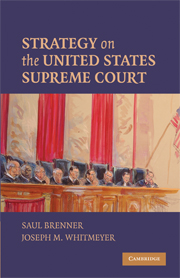Book contents
- Frontmatter
- Contents
- Preface
- PART I INTRODUCTION
- PART II CERTIORARI
- PART III THE CONFERENCE VOTE ON THE MERITS
- PART IV THE MAJORITY OPINION AND OTHER OPINIONS
- PART V THE FINAL VOTE ON THE MERITS
- PART VI CONCLUDING CHAPTERS
- 14 Strategies in Pursuit of Institutional Goals
- 15 Summary
- Appendix 1 Decision Making on the United States Supreme Court
- Appendix 2 Additional Questions to Explore
- References
- Table of Cases
- Index
14 - Strategies in Pursuit of Institutional Goals
Published online by Cambridge University Press: 05 June 2012
- Frontmatter
- Contents
- Preface
- PART I INTRODUCTION
- PART II CERTIORARI
- PART III THE CONFERENCE VOTE ON THE MERITS
- PART IV THE MAJORITY OPINION AND OTHER OPINIONS
- PART V THE FINAL VOTE ON THE MERITS
- PART VI CONCLUDING CHAPTERS
- 14 Strategies in Pursuit of Institutional Goals
- 15 Summary
- Appendix 1 Decision Making on the United States Supreme Court
- Appendix 2 Additional Questions to Explore
- References
- Table of Cases
- Index
Summary
Our previous discussion has focused mainly on the justices' pursuit of ideological or legal goals. Because the justices disagree regarding what ideology or interpretation of the law they favor, when an individual justice pursues her ideological or legal goals she does so at another justice's expense.
The justices, however, have shared goals as well. They want the Court to decide cases efficiently. They seek harmonious relations with each other, and they want the Court to be autonomous, influential, and respected. These shared goals are secondary goals. It is doubtful, for example, that any justice's primary goal is to have harmonious social relations on the Court or even to maximize the Court's influence. These shared goals almost certainly are not the ultimate aims of the justices. Nevertheless, the attainment of these secondary goals will often facilitate or enhance the primary goals, which are likely to be attitudinal or legal.
Strategies are often helpful in attaining these shared goals. These may be called “coordinating strategies” or, if they involve formal rules, “institutional strategies.” Supreme Court scholars have not paid a great deal of attention to these strategies, but it is important to do so to understand decision making on the Court. In this chapter we argue that the following rules may make sense in light of such goals:
The Rule of 4 for cert decisions
Independence of the cert vote and the merits vote
Rules regarding access to the Court
Outcome voting
The narrowest grounds rule
Respect for precedent (stare decisis)
[…]
- Type
- Chapter
- Information
- Strategy on the United States Supreme Court , pp. 139 - 160Publisher: Cambridge University PressPrint publication year: 2009



